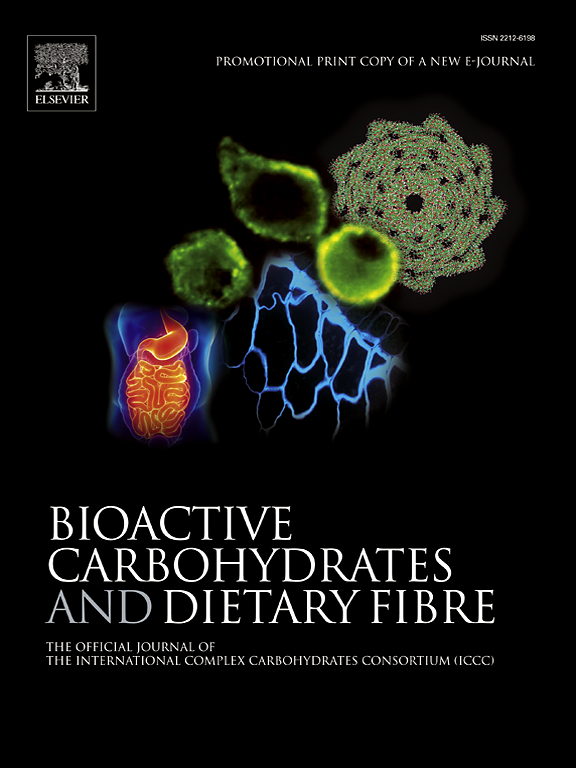Fridericia chica提取物的微胶囊化:稳定性,花青素保留,以及食品和治疗应用的抗氧化特性
IF 3.6
引用次数: 0
摘要
related fridericia china(美国)L.G. Lohmann (syn. Arrabidaea chica Verlot)是一种药用植物,传统上被亚马逊河流域和热带南美洲的土著社区和当地居民使用,因为它具有抗氧化、抗炎和抗癌活性,这归功于它富含花青素的成分。目的通过喷雾干燥的微胶囊化工艺,提高水浸提法提取工艺中花青素含量,稳定活性成分。材料与方法用不同浓度的大溪地柠檬汁酸化矿泉水提取生物活性物质。以麦芽糖糊精或阿拉伯胶为保护基质,对花青素含量最高的提取物进行微胶囊化。高效液相色谱法(470nm检测器)鉴定出关键花青素(羟基卡拉朱龙、卡拉朱龙、卡拉朱龙苷)。总酚类化合物(TPC)、总黄酮类化合物(TFC)和抗氧化性能(ABTS、DPPH、FRAP)在冷藏(4°C)和室温(25°C)条件下保存180天。结果提取物微颗粒(FEC,对照)生物活性含量明显降低(TPC降低88%,TFC降低35%)。微胶囊化提高了稳定性:麦芽糖糊精微胶囊(FEMM)的总酚含量(TPC)损失7.15%,总黄酮含量(TFC)损失10.22%,而阿拉伯胶微胶囊(FEMA)的TPC损失最小(0.74%),TFC减少11.66%。在冷藏条件下,阿拉伯胶比麦芽糖糊精具有更好的抗氧化活性。结论微胶囊化显著提高了鸡毛苣提取物活性成分的稳定性,其中阿拉伯胶的稳定性优于麦芽糖糊精。这些粉末作为功能性食品配料具有很高的潜力,具有稳定性、抗氧化性和延长储存的适用性。本文章由计算机程序翻译,如有差异,请以英文原文为准。
Microencapsulation of Fridericia chica extract: stability, anthocyanin retention, and antioxidant properties for food and therapeutic applications
Relevance
Fridericia chica (Bonpl.) L.G. Lohmann (syn. Arrabidaea chica Verlot) is a medicinal plant traditionally utilized by Indigenous communities and local populations in the Amazon and tropical South America for its antioxidant, anti-inflammatory, and anticancer activities, attributed to its anthocyanin-rich composition.
Aim of the study
To enhance aqueous infusion extraction of processed F. chica leaves to maximize anthocyanin content and stabilize bioactive compounds through microencapsulation via spray drying.
Materials and methods
Mineral water acidified with varying concentrations of Tahiti lemon juice was used to extract bioactive compounds. The extract with the highest anthocyanin content was microencapsulated using maltodextrin or Arabic gum as protective matrices. High-Performance Liquid Chromatography (470 nm detector) identified key anthocyanidins (hydroxycarajurone, carajurone, carajurin). Total phenolic compounds (TPC), total flavonoid compounds (TFC), and antioxidant properties (ABTS, DPPH, FRAP) were assessed over 180 days under refrigerated (4 °C) and room temperature (25 °C) storage conditions.
Results
The extract microparticles (FEC, control) showed significant degradation in bioactive content (88 % reduction in TPC, 35 % in TFC). Microencapsulation improved stability: Microcapsules with maltodextrin (FEMM) exhibited a 7.15 % loss of total phenolic content (TPC) and a 10.22 % loss of total flavonoid content (TFC), whereas microcapsules with gum Arabic (FEMA) showed minimal loss of TPC (0.74 %) and an 11.66 % reduction of TFC. Refrigeration mitigated degradation, and Arabic gum had better-preserved antioxidant activity than maltodextrin under both conditions.
Conclusions
Microencapsulation significantly enhanced the stability of F. chica bioactive compounds, with Arabic gum outperforming maltodextrin. These powders demonstrate high potential as functional food ingredients, offering stability, antioxidant preservation, and suitability for extended storage.
求助全文
通过发布文献求助,成功后即可免费获取论文全文。
去求助
来源期刊

Bioactive Carbohydrates and Dietary Fibre
Agricultural and Biological Sciences-Food Science
CiteScore
6.00
自引率
0.00%
发文量
38
期刊介绍:
 求助内容:
求助内容: 应助结果提醒方式:
应助结果提醒方式:


